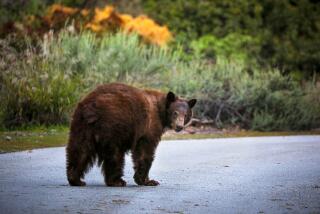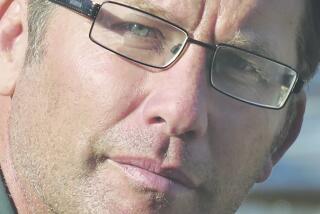The Hunter in Our Heart : BLOODTIES: Nature, Culture, and the Hunt, <i> By Ted Kerasote (Random House: $22; 320 pp.)</i>
Buried in our animal nature lies an important but unstated fact: The drive to hunt and the drive for sex have much in common. Both are atavistic and both can be thanked for our presence here today.
While the drive to hunt is less obvious than the drive for sex, the former probably contributed more to our culture. Sex is accomplished by two, but hunting is often accomplished in cohesive and enduring groups. Before we became hunters, we met our need for animal protein by snacking on insects, snails, fledgling birds and other slow creatures too small to share. But hunting produced large, festive meals too grand to be eaten by any one person, meals which could feed large groups of people who would stay around the carcass not only to be sure of their shares but also to defend the meat from scavengers. Hunting, therefore, made us social.
Guided by our two most important instincts, we’ve come a long way.
Nowadays, though, while a few would question the atavism of sex, the atavism of hunting tends to elude us. In many of us that atavism is muted. Yet the instinct is what electrifies us when we see wild animals, and is probably what makes some of us into zoologists, naturalists and wildlife biologists, who really are little more than hunters gone wrong.
On the other hand, certain people, myself included, hold that animals were not put on earth for our use, certainly not so that we can kill them for pleasure. To such people, sport hunting is no more exalted than pulling the wings off flies. What the issue comes down to, then, is this: Now that we have become an industrialized society, should we indulge our instincts at the expense of other intelligent forms of life? Is hunting still OK, or should we stick to photography?
That question has never been more intelligently addressed than it is in Ted Kerasote’s fascinating “Bloodties.” He points out that as long as we hunt locally (so that we don’t burn fossil fuel getting to our quarry) and as long as we eat the victim, we do infinitely less harm to the overall environment than we do by eating ordinary supermarket vegetables.
After all, the vegetables are grown by an energy-hungry agribusiness whose pesticides decimate the ecosystem and whose combines fatally batter hundreds of small animals (insects, toads, snakes, ground-nesting birds, mice, voles, woodchucks, striped squirrels, weasels, skunks, foxes) in the course of each harvest. But venison is in dramatic contrast to the vegetables resulting from that harvest, as well as to feed-dependent pork, beef, veal, chicken and turkey. Unlike agricultural produce, venison requires no pesticide or fossil-fuel to grow, and results in the loss of just one life: the deer’s.
Why don’t we all see this? Because to many of us, the little animals in the crops are vermin and the deer are Bambi, yet as Kerasote points out, life is precious to all creatures.
Kerasote hunts, probably very well. As a hunter he sounds more like an Inuit or a Bushman (or more like a wolf or a mountain lion, to name two other hunters of the deer) than like the camouflage-clad, beer-sodden macho types with automatic weapons who infest the woods each fall. And because he’s a hunter, Kerasote’s descriptions of hunts are realistic perfection.
If you want to know what hunting is like, you can learn from reading “Bloodties.” But beware: His unflinching descriptions of the deaths, being true, are real and therefore sad--and not for the faint-hearted. Yet his strong, sure prose never glorifies the death, or finds beauty in blood, a reticence that distinguishes his writing in a very welcome way from the sadistic scribblings of many other hunting literati. In short, if he hunts like the Inuit or the Bushmen, he also views the prey with the same pragmatic respect.
Yet deep ecology is but one theme of this excellent work. Kerasote explores the will to hunt (or the absence of it) in all its extremes. He hunts seals with Inuit men in Greenland, with whom he lived for a time. He interviews and goes trophy hunting in Asia with members of Safari Club International (SCI) on a quest for rare snow sheep. Visiting the trophy halls of these safarists, he meets one who was not ashamed to have shot a zoo tiger, or rare antelopes that at the time of their death were on the endangered species list. He also visits and attends the meetings of one of the most vocal anti-hunting groups in the country, and he talks with people who not only are vegetarians themselves but who force their dogs to be vegetarians too.
Meanwhile, interesting as all these people’s statements may be, the hunt itself is made additionally compelling by a secondary, unstated component: the relationship of hunting to sex. Not only are sex and hunting atavistic, but the instincts that inspire them seem to be related as well. And so Kerasote portrays them. “Killing is the orgasm of hunting,” he writes. One of his SCI companions claimed among his many assets some 200 trophy heads and “a nice-looking wife.”
Stories expressing this theme have been around a long time, traveling with the peoples who in Paleolithic times hunted along the edges of the glaciers, and who carried their animal wife myths from Asia into the New World, so that even today, these stories are told on the east or “far” side of Greenland. Kerasote doesn’t discuss these stories as such; he lives them. Kerasote’s own dream-like vision of the animal wife, in his case a hind he kills who materializes as a seductive woman, obviously came to him just as it came to the ancient people, and could have begun in a Magdalenian cave.
However, in the eyes of this reviewer, the most intriguing bit of evidence for the relatedness of sex and hunting is the sexual joking that accompanies hunting. Kerasote would probably not be surprised to learn that the jokes he shared with his Inuit friends are almost exactly the same jokes told by hunters on their long, hot hunting forays in the Kalahari--an argument for atavism if ever there was one.
Obviously, Gaea had something in mind when wiring sex to hunting in the human fuse box. Obviously, in many people that something has been short-circuited. What would Gaea think of the celibacy of anti-hunting? And what should she think of the trophy hunters with their helicopters, their semiautomatic weapons, their soft-pointed bullets? These toys are the vibrators of hunting, a perversion, just as stuffed, mounted trophies, especially of endangered species, are to the act of hunting what sexually molested children are to the act of procreation. Yet if Gaea were dismayed by what has happened to her handiwork, she could still feel pleased with Kerasote, who personifies the old ways. The world is lucky to have this book, since most people who know the old truths--people such as the Bushmen and the Inuit--aren’t writing books. They’re off hunting.






